Mark Carrara started at Muswell Hill in 1966, including a period
as Union rep there, before moving on as an Inspector, staying with
LT and successors for 30 years. He writes to supplement Stuart
Perry’s stories.
"When I was a conductor on the 210s, one of the regular
passengers was a gentleman of 90 years of age who had some very
interesting stories to tell. One sticks in my mind, was the fact
that he was employed in the horse-drawn days to couple up an extra
team of horses so the bus could get up Highgate Hill. The horses
were based just a short way down in Holloway Road.
And one passenger would regularly give me a pound note or a five
pound note for a sixpenny fare. I stopped him by giving him a five
pound bag of sixpenny bits, took one six pence out for the fare and
told him he now had plenty. He never did it again.
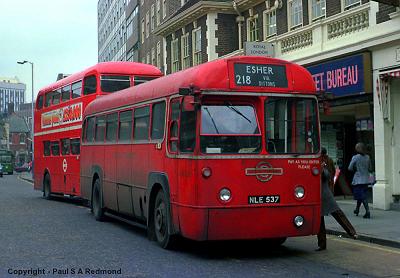 Having
stated life as a conductor on route 210 in 1966, I became a driver
on the route from 1967 right through to the Swift days. Faces and
names escape me after all these years, except for the Garage
manager Jim Collier and George Smith the Union Rep before me.
Having
stated life as a conductor on route 210 in 1966, I became a driver
on the route from 1967 right through to the Swift days. Faces and
names escape me after all these years, except for the Garage
manager Jim Collier and George Smith the Union Rep before me.
RF537 nears the end of its working life,
on the 218 in Kingston. The bus is now preserved by the
London Transport Museum and is stored at Acton.
Photo © Paul Redmond
It's funny that the although fleet numbers of the crew RF buses
in Muswell Hill at the time meant nothing to me, I remember two
particular buses, RF525 and RF537. These
two buses are notable in the crew days as being the only two that
had doors. On RF525, the doors were pinned back by a couple of bits
of wood on the platform. On the stand at Leytonstone Station one
Sunday, we tried removing the wood but the doors still didn’t work,
so we put the wood back. On RF537 on the other hand, the doors did
work and were never made not to – the best bus to have in the
winter. But when the green ones arrived they were both transferred
out.
When you think about it, though, the crew RF buses were quite
dangerous, as the fact of people jumping on whilst the bus was
moving, bearing in mind that the front wheel was very close to the
entrance. Needless to say there was the odd fatality caused by
people doing this. I recall at least two cases at Finsbury Park,
although I hasten to add that I was not involved in either of them.
And on RFs, doors were not linked to the gears, so they could be
opened and closed at any time. Handy in the summer.
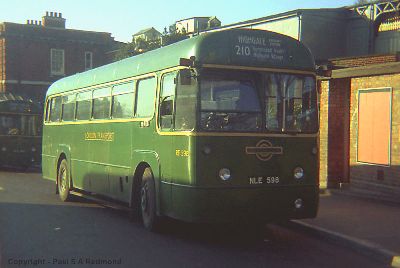 When the green ones arrived, it was interesting during
the first week or so, as passengers just let us go by, even
standing back at compulsory stops. The incidents of passengers
attempting to jump on whilst the bus was moving gradually stopped,
but those that did found themselves hanging on the outside with
their nose up against the doors. Funny to see but frightening.
When the green ones arrived, it was interesting during
the first week or so, as passengers just let us go by, even
standing back at compulsory stops. The incidents of passengers
attempting to jump on whilst the bus was moving gradually stopped,
but those that did found themselves hanging on the outside with
their nose up against the doors. Funny to see but frightening.
RF598 was one of the
batch of green RFs transferred in to
Muswell Hill in 1969. It is seen at Golders Green ready to
depart for Archway on a short working. Note the blind
'Highgate Archway Station'.
Photo © Paul Redmond
As an OMO driver at Finsbury Park once, I lost a half crown in
the cab, practically lost a whole rounder looking for it. Half a
crown was a lot of money then. In fact it fell though the handbrake
gaiter and landed on the chassis (see the garage manager).
As a driver the only fault with the RF was that, if the hand
brake was a bit weak and you pulled it up a bit quick, your elbow
would hit the air intake pipe in the corner of the cab. I still
have the scars. Also if you went over a bump a bit quick, you were
thrown up out of your seat and lost your sight line for a second or
two. I am thinking of the cambers in Homerton where the side
turnings caused the bus to lift (probably smoothed out by now).
Yes, it made a great change to go to Leyton on a Sunday, although
not many drivers knew the way and it might only be once in a shift,
as the rest of the duty was doing Golders Green to Finsbury Park
shorts. And yes quite a few crews got lost; I particularly remember
seeing the same bus who was attempting to get to Golders Green,
three times coming out of various side turning as we went to
Leyton, with a bus full of bemused passengers.
Incidentally, the reason the 210 garage workings seem so
peculiar now, is the fact that the Archway was not a roundabout at
that time, and due to the bus stop locations which had to be
served, you could not use the Archway Road. The Archway became a
roundabout in the mid 70s and I remember when they were digging,
they dug up the old tram lines which were still under the
tarmac.
Just one other comment, I do not remember the RF having to use
first gear up Highgate Hill. But I do remember that with the old
RTs on the 212s, you had to use first,
especially if you had to stop at the request stop half way up
Muswell Hill. And the poor old things were always wanting water by
the time we got on the stand.
The RTs on the 212 used to frighten me a bit, because when you
pulled out of Wells Terrace into Stroud Green road with a full bus
and looked in the nearside mirror, you could see the whole profile
of the tyres, as the bus leant over so far.
I have to say out of all my experiences the RF was the best bus
to drive.
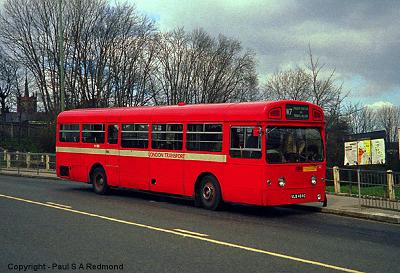 As
for the SMS, I remember on one occasion when only three of us
operated the 210 as all the others had broken down and were unfit.
The MBSs on the W7 (the old 212) were a much better bus and were
able to charge up Muswell Hill with their 11 litre engines. Not
only was the MBS faster, it had electric doors which were very
quick. You had to watch this, as you could speed up people getting
on the bus by the fact you could hit them up the rear as they were
still getting on. However due to the length of the MBS the body
tended to twist a bit, which caused the centre doors to jam open on
a camber, and you had to ask a passenger to give them a tug.
As
for the SMS, I remember on one occasion when only three of us
operated the 210 as all the others had broken down and were unfit.
The MBSs on the W7 (the old 212) were a much better bus and were
able to charge up Muswell Hill with their 11 litre engines. Not
only was the MBS faster, it had electric doors which were very
quick. You had to watch this, as you could speed up people getting
on the bus by the fact you could hit them up the rear as they were
still getting on. However due to the length of the MBS the body
tended to twist a bit, which caused the centre doors to jam open on
a camber, and you had to ask a passenger to give them a tug.
Muswell Hill's MBS464 on the W7.
Photo © Paul Redmond
The MBSs also had rather long overhangs at the front and rear,
as a result I remember shop blinds being knocked down on occasion
when a bus had to put on a hard right hand lock to pull out from
the stop because of a parked car, which caused the rear to go over
the kerb taking out the blind that was close to the kerb. It
happened a lot in Stroud Green Road on the W7s.
Also funny was that the MBSs were fitted with internal and
external speakers which were controlled by the driver who had the
mic. Needless to say these were somewhat abused, as drivers sang
through them and even whistled at girls in the street, so they were
disconnected after a time.
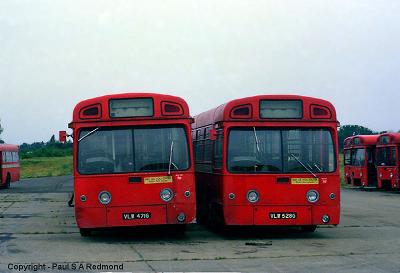 For a short
while the SMS was replaced by MBs brought out of the scrap yard for
the 244 due to the continual failures of the SMSs. This came about
because the drivers were getting fed up with sitting in the canteen
all day, day after day, because of insufficient serviceable buses -
mainly the SMSs - which caused horrendous problems for the 210 and
244. As union Rep at the time, we called a meeting at Manor House
(Eastern Division headquarters) to call on management to do
something. When we suggested that they put back into service some
of the MBs which were sitting in a field in Radlett, they were
quite shocked by the request but agreed. Within a couple of weeks
we got five of them for the 244 having been refurbed.
For a short
while the SMS was replaced by MBs brought out of the scrap yard for
the 244 due to the continual failures of the SMSs. This came about
because the drivers were getting fed up with sitting in the canteen
all day, day after day, because of insufficient serviceable buses -
mainly the SMSs - which caused horrendous problems for the 210 and
244. As union Rep at the time, we called a meeting at Manor House
(Eastern Division headquarters) to call on management to do
something. When we suggested that they put back into service some
of the MBs which were sitting in a field in Radlett, they were
quite shocked by the request but agreed. Within a couple of weeks
we got five of them for the 244 having been refurbed.
Two MBSs stand a Radlett
Airfield in about February 1976, the month that at least MB329
returned from Radlett to be reinstated at MH - several of the
others reinstated had in fact been in store at other garages.
Neither 471 nor 528 escaped, both going to Wombwell Diesels
for scrap later that year.
Photo © Paul Redmond
The SMS had three main failings, (a) it was under powered (8
litre engine), (b) the doors which were air operated and were so
slow to close, and (c) there was/is a radiator just by the back
door under the internal step that got blocked, which the engineers
claimed they could not get to without taking the bus apart, which
caused the heaters not to work.
Of course during the seventies there was a severe shortage of
staff, and with the continual breakdowns things went from bad to
worse. As with the introduction of the DMS which replaced the MBs,
they were actually no better at first due the fact that the brake
shoes had to be changed every six weeks on the early ones.
In the early years of my time with London Transport, say 1966 to
1969, it was still a very regimented operation. You were not
allowed to leave the bus stand until the inspector blew his
whistle, even though you had a full bus and the conductor had even
collected all the fares before moving off. This was mainly at
Finsbury Park.
With the clock cards along the side of the road and at Muswell
Hill Broadway stand, you dare not clock out early. In some cases it
got to the stage where the driver would start pulling away (slowly)
and the conductor had to jump on as the bus was moving.
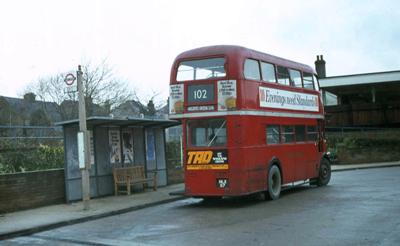 There was a sorry story about the clocks, which refers
to an incident at Pimlico on the 134s. The conductor who was renown
for being a bit slow ringing the bell, got off at Pimlico Square to
clock the card. And the driver drove off without him. It was not
until reaching Kentish Town that the driver realised he did not
have a conductor on board. We worked out that he had passed 21
compulsory stops, let alone the request stops he picked up at
without noticing. Needless to say the driver did not last long. The
last clock I remember was on the North Circular Road at its
junction with Finchley Road, on route 102 that we used to do on a
Sunday.
There was a sorry story about the clocks, which refers
to an incident at Pimlico on the 134s. The conductor who was renown
for being a bit slow ringing the bell, got off at Pimlico Square to
clock the card. And the driver drove off without him. It was not
until reaching Kentish Town that the driver realised he did not
have a conductor on board. We worked out that he had passed 21
compulsory stops, let alone the request stops he picked up at
without noticing. Needless to say the driver did not last long. The
last clock I remember was on the North Circular Road at its
junction with Finchley Road, on route 102 that we used to do on a
Sunday.
The end of the 102. RT280 at Chingford
Station.
Photo © John
Parkin
With regards to the clocks, as far as I remember there
were three at Golders Green; the one that served the 102 was
near the footpath that connected the stand with the main stand, the
other two were in the main stand, one being near the inspectors'
hut serving route 2 and 28 and the other was opposite near the
('dug out') crew refreshment room in between the hut and station
entrance.
[Andrew Colebourne adds that 'the
102 stand was in the trolleybus turning circle from 1955
onwards. Apparently post-War the circle was very rarely used
by trolleybuses (the need for short workings having reduced
following the Northern Line extensions to Finchley and Barnet/Mill
Hill East). There are hardly any pictures of trolleybuses using it
but plenty of pictures of buses from early post-War onwards.
Of the other clocks mentioned, photographic evidence suggests the
one near the 'dug out' on the Hippodrome side was installed there
in the mid-1960s. I don't know when the others were
installed but I think they were all removed at the same
time when the bus station was extended and loading islands
installed c1973.']
When I became an Inspector for the second time, I went to Potter
Bar as a volunteer in 1986 when LT deemed that this was the garage
that was the experiment in privatisation; I was at Brent Cross
before this. There was a 242 that was scheduled at Cuffley station
at about 1:25 in the morning. Why? was the question, as there were
no trains or people to pick up. It turns out that the bus used to
serve a potato-pickers train to get the workers home. But that
stopped running in 1941, but the bus kept going until a re-schedule
in 1987. Crazy when you think about it. But it was a very good job
and I do not regret a minute of it."
Thanks Mark.